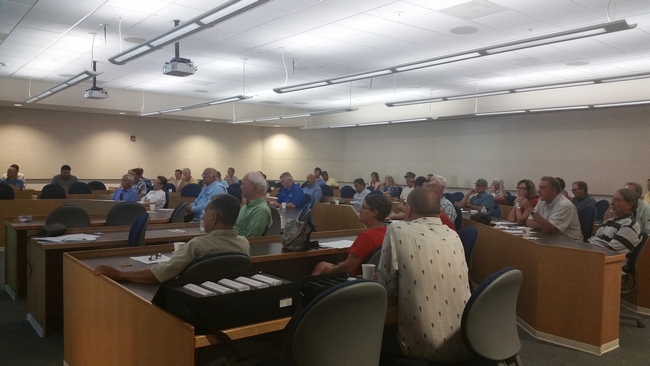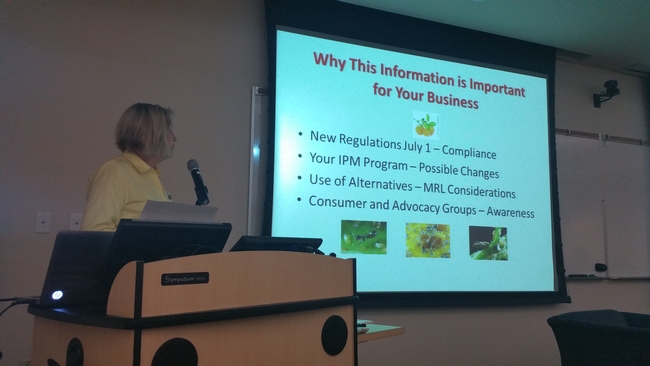
Posts Tagged: parasitic
Fire, Ash, Citrus and Pests
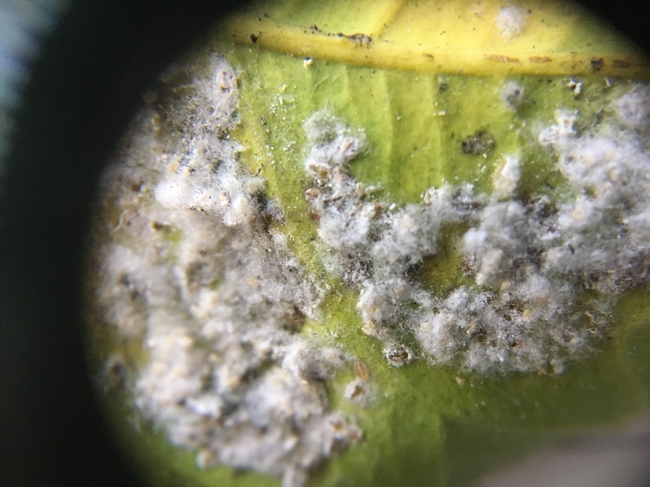
Wow, woolly whitefly covered with waxy, curly filaments , Aleurothrixus floccosus.
One of the consequences of fire and the resulting ash is that the biocontrol agents that keep whiteflies, scale, mealybug and other pests in balance is that they will spend so much of their time preening that they don't have time to go after their prey. Lacewing larvae, minute pirate bug, ladybird larvae, parasitic wasps and others rely on moving around to get at their food sources. When they cant move fast, they stop and clean their joints to stay limber. Whitefly and scale insects just hunker down and don't need to do a lot of moving. They just breed, and without actively moving biocontrol agents, their populations can explode. Or that's my human analogy. In dusty areas or areas affected by ash, the particles get in their joints and they need to spend time cleaning in order to move fast.
Whiteflies suck phloem sap, which in some cases can cause leaves to wilt and drop when there are high numbers of whiteflies. However, the primary concern with whiteflies is the honeydew they produce. Honeydew excreted by nymphs and adults collects dust and supports the growth of sooty mold; large infestations blacken entire trees, including fruit, as well as attract ants, which interfere with the biological control of whiteflies and other pests. The sooty mold can also affect tree yields by reducing photosynthesis and requiring extra handling time for cleaning.
So pests under good control prior to a fire can get out of hand. This is a good example of a tree in the town of Ventura where ash was a problem. A seemingly clean tree, free of whitefly, started to defoliate with blotchy leaf spots. On the undersides of the leaves corresponding to the blotches are colonies of whitefly. And looking closely you can see that some of the nymphs have exit holes, indicating that they have been parasitized by a wasp. So nature is kicking in and taking it's course. The whitefly should get cleaned up soon too by some forager, such as lacewing larvae or pirate bug. No need to spray because it would just be a further disruption.
See more about whiteflies at:
http://ipm.ucanr.edu/PMG/PESTNOTES/pn7401.html
Photos: Defoliating 'Meyer' lemon tree, blotches on upper side of leaf, whitefly colonies with exit holes in some of the nymphs
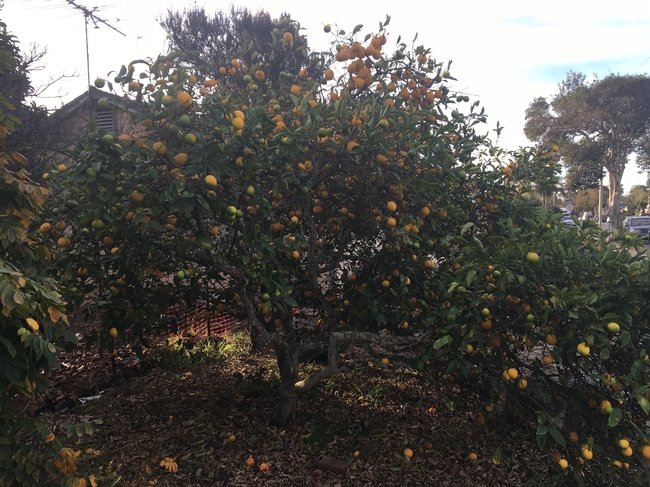
lemon leaf drop
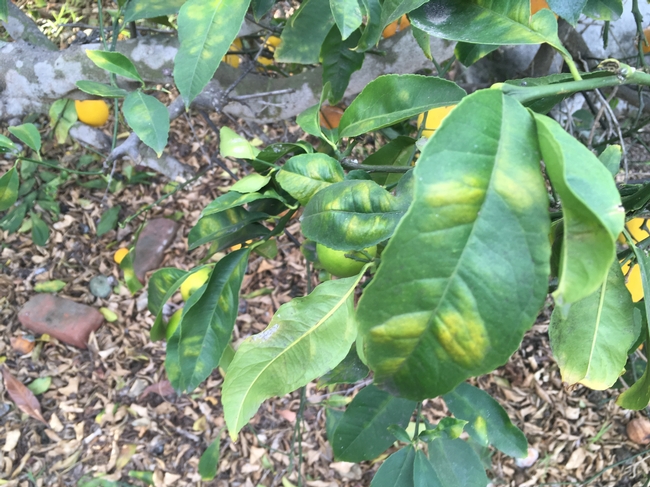
lemon leaf blotch
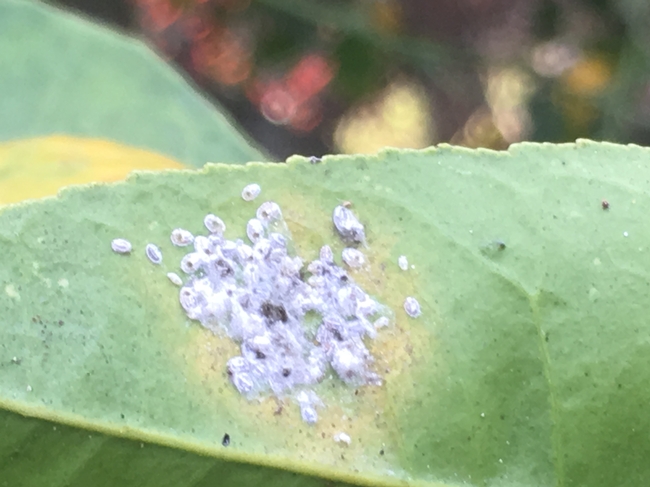
lemon scale
“We Shall Defend our Citrus, We Shall Fight in Backyards and Community Gardens, We Shall Fight in Organic and Conventional Citrus Orchards; We Shall Never Surrender.”
Extension Specialist in Biological Control, Department of Entomology, University of California Riverside, CA 92521mark.hoddle@ucr.edu
Well, what a dramatic title, and it is certainly an unabashed rip off from Winston Churchill too! However, many growers in California view the threat posed to the long term viability and profitability of citrus by Asian citrus psyllid (ACP) and huanglongbing (HLB) as a war! ACP is a small sap sucking insect that is native to the Indian subcontinent and it has emerged as a global threat to citrus because it vectors a bacterium (Candidatus Liberibacter asiaticus [CLas]) that causes a lethal and incurable citrus disease, huanglongbing (sometimes referred to as citrus greening). Trees displaying HLB go into decline and some varieties may die in as little as 5-8 years post-infection. Symptoms may include chlorotic leaves (Fig. 2) and premature fruit drop. Fruit that are retained become misshapen as they develop, ripen irregularly (hence the common name citrus greening), and have a bitter taste. Florida's “war” with ACP and HLB started around 1998 when the psyllid was first found, then in 2005 the first citrus trees with HLB symptoms were discovered. Some economic estimates of the ACP-CLas epidemic in Florida suggest that more than 8,000 jobs have been lost, production has declined by 23%, and revenues have dropped by 16% .
ACP was first detected in southern California in 2008, and in 2012, the first citrus trees with HLB symptoms were found in Hacienda Heights in Los Angeles County. Subsequently, HLB has been confirmed in San Gabriel, also in LA County. Detections of ACP in the San Joaquin Valley (SJV) are increasing, especially around Bakersfield, and these finds make the largest citrus production areas in California highly vulnerable to CLas. One response to the ACP invasion has been to go after the vector in urban residential areas where ACP enjoys a relatively good life on backyard citrus trees that are treated infrequently with pesticides. The intention of this urban-residential-ACP control program was to knock back psyllid numbers to low levels with the goal of reducing the rate of spread of ACP and CLas through urban areas and into commercial citrus production zones. Vector reduction have been attempted in two different ways; spraying insecticides and biological control. The California Department of Food and Agriculture aggressively pursued residential spraying of citrus during the initial stages of the ACP campaign in southern California, but this quickly became unsustainable due to cost and the speed at which ACP was spreading through the urban landscape. Spraying is still used in areas were ACP populations are small and localized, such as those being found in parts of the SJV.
The second approach has been to run a classical biological control program targeting ACP. Classical biological control introduces natural enemies from the home range of the pest into the invaded area with the goal of establishing these beneficial agents so that they permanently suppress pest populations to less damaging levels. This approach necessitated searches for ACP natural enemies in the native range of the pest, a process referred to as foreign exploration. Because ACP has a huge putative native range, foreign exploration was conducted in Punjab Pakistan (Fig. 3), an area with ~70% climate match with the major citrus production areas in the SJV. A good climate match, in theory, should result in natural enemies that are pre-adapted to California's hot dry summers and cool damp winters. From September 2010 to April 2013, six expeditions searching for ACP natural enemies were conducted in Pakistan. The University of Agriculture Faisalabad (UAF) was the home base for this project. Collaboration with UAF Faculty was excellent, and the Vice Chancellor of UAF, Dr. Iqrar Khan, is a UC Riverside graduate in plant pathology, and Mike Roose was Iqrar's major professor!
Two species of parasitoid, Tamarixia radiata and Diaphorencyrtus aligarhensis, were found attacking ACP in Pakistan. Both species were returned to the Insectary and Quarantine Facility at UC Riverside. Mandatory host range and host specificity tests were conducted over a 2-3 year period and results indicated that both species likely posed little environmental risk to California and it was concluded that both species offered significant benefits because of their ability to parasitize and feed on ACP nymphs. Both of these processes kill ACP nymphs. Consequently, USDA-APHIS issued release permits and CDFA took over the mass rearing of these parasitoids. As of June 2016, more than 3 million Tamarixia and 170,000 Diaphorencyrtus have been released in southern California.
Initial results of the ACP biocontrol program are promising. Tamarixia appears to have established widely in southern California, and in combination with other species of natural enemies, especially generalist predators like lacewing and syrphid fly larvae, significant reductions in ACP populations have been documented. Diaphorencyrtus lags behind Tamarixia because it was the second parasitoid out of the quarantine pipeline, but multiple recoveries have been made at about 60% of sites where this species has been released. However, the impact and rate of spread of Diaphorencyrtus and whether it can compete successfully with Tamarixia is unknown and the subject of Citrus Research Board (CRB) and USDA-MAC sponsored research.
Although the major biocontrol efforts have centered on ACP in residential areas in southern California, the focus of the biocontrol program, especially with respect to Tamarixia, is beginning to face northwards, and battle lines are being drawn around and through Bakersfield and Tulare. The redirection of effort has been the subject of intense discussion at recent CRB BioControl Taskforce meetings. The emerging consensus is that movement of biocontrol agents into urban areas north of the Tehachapi mountains is needed. It is highly likely that in late 2016 or early 2017 Pakistani mercenaries will be released for the first time into the SJV to hunt down ACP.Asian citrus psyllid, Diaphorina citri, is an invasive pest in California. Immature psyllids, the nymphs (A) acquire the HLB-causing bacteria when feeding on infected plants. (B) Adult psyllids can carry bacteria between trees and inoculate healthy plants when feeding (Photos by Mike Lewis, Center for Invasive Species Research, UC Riverside)
ACP and Nymph
Tamarixia

ACP adult and nymph

tamarixia
Annual Citrus Grower Seminar in Southern California: A Review
The Citrus Research Board in conjunction with the University of California Cooperative Extension (UCCE) held their annual grower seminar on Tuesday, June 30, 2015 at the University of California, Riverside (UCR) Palm Desert Center. Seminars also took place in Santa Paula, CA on June 25th and in Exeter, CA on July 1st. Speakers from all over the state from different agencies shared their knowledge and expertise with the group.
Mark Hoddle, a Biological Control Specialist at UCR gave an update of the biological control of Asian citrus psyllid (ACP). The ACP's natural enemy, Tamarixia radiata has been successful since its release in Southern California in 2011. The Tamarixia kills the ACP nymphs either by parasitizing them (i.e., females eggs laid underneath ACP nymphs and the parasitoid larvae burrow into the nymph to feed which kills the pest) or by host feeding (i.e., female parasitoids stab the nymph with their ovipositor, a tube that they use to lay eggs, and they feed on the body juices that leak from these wounds. This kills the nymph too). Hoddle reminded us, in order for this biocontrol program to continue to be successful, ant populations must be controlled. ACP nymphs produce a white, sugary waste product called honeydew, a good carbohydrate source for the ants, therefore, the ants will protect the nymphs from Tamarixia. His current research showed that when an ant population is reduced, parasitism control increases significantly. Hoddle and his lab will be testing different organic and conventional pesticides for their efficacy against Argentine ants in citrus orchards.
For example, he is in the works of helping produce a more effective ant-bait by working on a biodegradable hydrogel. These hydgrogels are made from algae and crab shells. The material is engineered to encapsulate a 25% sucrose solution with a tiny amount of pesticide and ant pheromone. The liquid bait "leaks" onto the surface of the hydrogel, ants drink it, take it to the nest and slowly intoxicate the queen and nest mates. The baits, about the size of a jellybean, will be engineered to have a certain life time before they "dissolve". He anticipates these jellybean like baits being able to be broadcasted under trees (like you would slug/snail pellets) and the pheromone will attract the ants to them. Once they start to feed, the ants will lay down their own trails to the baits. Mark Hoddle is also the director of the Center for Invasive Species Research, for more information regarding his work on biocontrol, please visit: http://cisr.ucr.edu/.
Victoria Hornbaker, from the California Citrus Pest & Disease Prevention Program Manager and grower Curtis Pate, also the grower liaison from Imperial gave updates on the current ACP management areas (Fig. 1). Curtis, reminded the growers, ACP is attracted to bright colors, such as yellow. Yellow is a common color for most safety vests and jackets, this creates an issue because most people that own one of these pieces of clothing are unaware that they can very well be unknowingly transporting this pest to different locations (Fig. 2). Basic measures such as rolling up vehicle windows, shaking off clothing 
Lori Berger, with the UC Statewide Integrated Pest Management (IPM) Program gave an update on the Chlorpyrifos Critical Use Project (Fig. 3). The project is a multi-year effort to identify the pest management needs and practices for use of Chlorpyrifos in important crops in California. To accomplish this goal, Department of Pesticide regulation (DPR) contracted with UC IPM program to convene industry leaders to work together to create commodity specific guidelines for specific cropping systems. Chlorpyrifos is used on critical citrus pests such as ants, ACP, scales, bud mite, leafminers and many other arthropods. Growers are required to now obtain a restricted materials permit from their local County Agricultural Commission since DPR has designated the insecticide for restricted use in California as of July 1, 2015. The permit conditions may include buffer zones near sensitive sites, good management practices to reduce drift or offsite movement into the air and measures to reduce runoff into surface waters. For Southern California growers, a more in depth meeting will be held at the San Diego Farm Bureau in Escondido on September 15, 2015, more information on this meeting will available in the near future. DPR hours for laws and regulations will be available. More information on the Chlorpyrifos Critical Use Project can be found at: http://www.ipm.ucdavis.edu/IPMPROJECT/CDPR_Chlorpyrifos_critical_use_report.pdf.
Ben Faber, a UCCE Farm advisor from Ventura/Santa Barbra County gave a great presentation on how to interpret soils/water/leaf analyses and managing water in a drought. Soil and water reports are best used for identifying problems in: 1) pH (power of hydrogen); 2) salinity (how much salt is in the soil); 4) chloride (Cl-); 5) sodium (Na+); 6) boron (B); and 7) sodium adsorption ration. Most of the issues listed can be managed by leaching. Unfortunately, there are no definite measurements for fertility management of perennial crops, however, understanding the fundamentals of interpreting analyses is key for a healthy producing grove. For example, when one is handed a report, many may get overwhelmed by the sight of all these things that are reported. Many of those numbers are only on there because they are required to be there by law and may not have an importance to you as grower when it comes to management decisions. You may ask yourself, what is really important in all this? Faber, gave the growers a quick review, for example, in a water analyses we would want to look for look for some basic ranges in: Boron, this element should be no higher than 1 parts per million (ppm), sodium and chloride no higher than 100 ppm, and the TDS (total dissolved solids), this may also be known to some as EC (electrical conductivity), should be no higher than 1,000 ppm. Simple, right?
When dealing with pH, it is always best to balance that out before one plants trees. Trying to balance the pH after a crop has been established can be challenging and you may run the risk of injuring or killing your trees in the process. Those that would like to learn more on soils/water/leaf analyses and managing water in a drought, you can visit Ben Faber's UCCE County website: http://ceventura.ucanr.edu/Com_Ag/Subtropical/.
Neil McRoberts. Professor of Plant Pathology from UC Davis had interactive question and answer session with the audience, gathering grower's views on approaches of control for ACP/ Huanglongbing, also known as citrus greening disease. The answers to this survey will be helpful in creating a management plan to better help growers with their ACP treatment and preventative planning. Michelle Richey, assistant Director of Food Safety from Ott and Davison Consulting also gave a quick update on Food Safety and Good Agricultural Practices certification. She stressed on how important it is to keep records of everything that happens in a business and to have them accessible.
We had a great turn out and hope to see more growers at next year's Southern California meeting.

